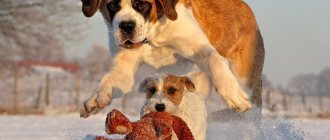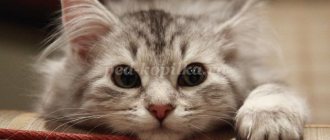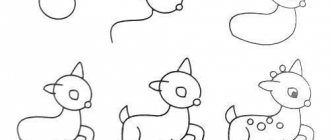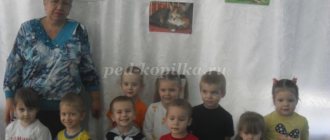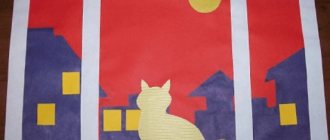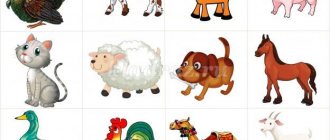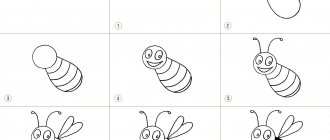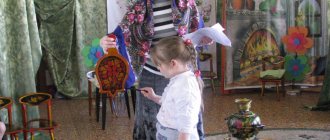Goals:
Introduce a new type of unconventional drawing technique - painting with a sponge.
Tasks:
Cultivate observation and a kind attitude towards pets.
Introduce a new genre of painting – animalistic.
Develop creativity, imagination, independence
Materials and equipment:
pictures of cats; album sheets of paper, gouache, palette, brushes, sponges for drawing.
Preliminary work
:
1. Conversation on the topic “pets”.
2. Observation of pets, cats, on a walk, at home;
3. Looking at illustrations of pictures with cats;
4. Reading poems, fairy tales;
5. Watching cartoons “Tom and Jerry”, “Leopold the Cat”.
cognition, social and communicative development, speech development.
Preview:
Summary of a lesson in visual arts using an unconventional drawing technique - painting with sponges.
Topic: “Pets are our friends”
Goals: To introduce a new type of unconventional drawing technique - painting with a sponge.
Tasks:
Cultivate observation and a kind attitude towards pets.
Introduce a new genre of painting – animalistic.
Develop creativity, imagination, independence
Materials and equipment: pictures of cats; album sheets of paper, gouache, palette, brushes, sponges for drawing.
Preliminary work:
1 . Conversation on the topic “pets”.
2. Observation of pets, cats, on a walk, at home;
3. Looking at illustrations of pictures with cats;
4. Reading poems, fairy tales;
5. Watching cartoons “Tom and Jerry”, “Leopold the Cat”.
Integration of educational areas: cognition, socio-communicative development, speech development.
GCD move.
Educator: Children, today we will have an art lesson.
Let's first remember what genres of painting you know.
Paintings depicting nature are called Landscape.
Paintings depicting beautiful things and objects are called still life.
Drawing a person's face is a genre of Portraiture.
Today we will get acquainted with a new genre of painting - Animalistic.
Educator: Remember, guys, if any animal is drawn in the picture, then this is an animalistic genre. The word animal means animal in English. Therefore, artists who draw animals are called animal painters.
Educator: At all times, people loved, tamed animals, observed them, and reflected their observations in works of art: paintings, book illustrations, sculptures, frescoes, painting of household items. Today we will be animal artists. If you guess the riddle, you will find out who we will draw.
All shaggy
Four paws
She herself has a mustache, two yachts under her hat.
(the teacher shows the cat toy)
Educator: Who has cats, raise your hand. Tell me what kind of cat is yours? What color is her coat and eye? What does she like?
(Children talk about their pets)
What should you take from this riddle to depict a cat?
Children's answers:
1. The texture of the fur is shaggy.
2.The number of paws is four.
3. The presence of a mustache, and quite long.
4. Sparkling eyes, different in color from the color of the animal.
Educator: About cats, like other animals, people compose fairy tales, write poems and stories. Remember in which fairy tale the cat was inherited by its owner? (Puss in Boots)
What is the name of the cat - the hero of the American animated series, who cannot catch Jerry the mouse? (Tom)
Name the cat who likes to say: “Guys, let’s live together!” (Leopold)
Educator: Today we will draw a mischievous kitten (cat).
We will paint it not just with brushes, but with a sponge. To do this, we will create an outline of the cat on the sheet, and use a sponge to dab the paint onto the sheet. The cat will be voluminous and fluffy.
We will paint the eyes and nose, as well as the mouth and mustache with a thin brush. And in order for our kitten’s eyes to be alive, we need to put a spot of white highlight on the pupil. And so that the cat doesn’t feel sad, you can draw her favorite toy nearby.
Independent work of children.
Educator: Now I propose to arrange an animalistic exhibition. Guys, look what beautiful cats we have made. Everyone has different, different colors. Which cat did you like best? Why ? (children's answers).
Educator: Children, what genre did we get acquainted with today (children’s answers). Correctly animalistic. You all did well today, you worked like real artists.
Summary of direct educational activities on the topic: “Pets.”
Description of the material:
I offer you a summary of direct educational activities for children of the preparatory group with OHP on the topic: “Pets.” This material will be useful to teachers - speech therapists, educators.
Goals:
Correctional and educational: - systematize children’s knowledge about domestic animals and their cubs. — teach children to coordinate numerals with nouns. — continue to teach children to coordinate speech with movements.
Correctional and developmental: -expand and clarify vocabulary; -form lexical and grammatical means of the language; -continue to develop grapho-motor skills. -develop children's attention, thinking, and observation skills;
Correctional and educational: - to instill in children a love for animals.
Equipment
: pictures of domestic animals and their cubs, cards with outline images of domestic animals for counting, individual cards with images of domestic animals superimposed on each other, pictures of wild animals (hedgehog, wolf), colored pencils, magnetic board, magnets.
Progress of the lesson
1. Organizational moment
Children enter the office and stand near their desks.
Speech therapist: “Now the one who can name the animal that gives milk will sit down” - Cow, goat. Who guards a person's house? - Dog. Who provides the wool? - Sheep. Who catches mice? - Cat. Who helps a person transport heavy loads, harvest crops, plow the land? - Horse. Well done! Right! What animals did we call? - Domestic ones. 2. Game “One - many”.
Now, guys, look carefully at the picture. Who is depicted on it? - Cat.
Let's call her cubs. - Kittens. What if there is only one? - Kitty. Who is in the next picture? - Dog. Who are her cubs? - Puppies. What if there is only one? - Puppy. (Pig - piglets - piglet; horse - foal; cow - calf; sheep - lamb; rabbit - little rabbit; goat - kids).
3. Exercise “Who was who?”
Let's remember who the animals were when they were little? The dog was a puppy, the horse was a foal, the cow was a calf, the pig was a piglet, the cat was a kitten.
4. Physical exercise
Guys, let's get up from the table and line up in a semicircle. Listen to me carefully and do as I do. Squat down, pat yourself on the stomach, stand up, stretch and stroke your stomach with your hands. The cat sat down under a bush, ate a piece of cheese, the cat stood up, stretched, and her fur unfurled.
5. Game "Count."
Now take the leaves that are on your tables. They depict animals. Now everyone will take turns counting how many animals they have drawn. (5 pigs, 5 cows, 5 goats, 5 cats, 5 hares, 5 dogs). 6. Exercise “Is the fourth wheel?” Guys, look carefully at the pictures, what animals are depicted in them? Let's list them. - Pig, cow, wolf, cat. Well done! Do these animals all fit together? Which animal is the odd one out here? - Wolf. Right, why? - Because the wolf is a wild animal, and all the others are domestic. Who is depicted in the following pictures? - Rabbit, dog, goat, hedgehog. Who's the odd one out? - Hedgehog. Why? - He's a wild animal.
7. Coloring book.
Now, guys, take the leaves that lie in front of you and look at them carefully. What animals are depicted on them? - Homemade. Let's list them all together. - Horse, rabbit, cow, pig, dog, goat. Well done! Now listen to me carefully. I'll tell you a riddle, and you try to guess it.
He sits in a barn, in a cage. There are balls of fluff with him - children. He gnaws cabbage deftly, he also loves to gnaw carrots. He still looks like a bunny. Who is this? Guess it? - Rabbit. That's right, now find the rabbit among the other animals and color it.
8. Summary of the lesson.
Guys, what did we do in class today? — We counted animals. — We remembered the benefits that pets bring to humans. - They called baby animals. — We guessed a riddle. — We painted the rabbit. — We found a fourth extra.
The favorites of all young children, of course, are pets. Mecking and running, they are so attractive. So a little person, coming from a petting zoo or looking at a picture in a book, wants to draw something like him. Well, nothing could be simpler. We offer you step-by-step lessons on how to draw pets. Simple lines and simple shapes will turn into a cow or a goat before your eyes. These drawings are so easy to repeat that the master classes are suitable for the youngest children, and they will succeed. Of course, under the guidance of adults :)
Drawing a horse
As you can see, everything is easy and simple. Beautiful creations for you and your children!
I am glad to welcome you, dear readers, who have already become friends! Tatyana Sukhikh is with you and today I want to talk about drawing animals. Have you ever wondered why we love animals? There are different versions, like scientific ones, but there is no exact answer about the reasons for our sympathy for the animal world. Everything happens at the subconscious level, doesn't it? Animals, including wild ones, evoke a special warm feeling in children.
It is clear that drawing animals is their favorite pastime. Perhaps we like something about cats, bears, and dogs that we don’t like in humans? How do you think? Or are we touched by the relative defenselessness of the “fluffies”?
Be that as it may, in kindergarten and at home, children sculpt and draw different animals with great pleasure. Therefore, in this series of materials, I cannot fail to mention how my students and I depict representatives of the fauna with pencils and paints.
What I like about the Internet is that every question has a more or less clear answer and that there are different educational materials.
I trust only trusted Internet portals, so I recommend only what I am absolutely sure of. For example, if you need books that will help you master drawing skills, look for OZON.RU.
I personally found the following:
An excellent book “How to draw any animal in 30 seconds” - this is especially for parents who are not very good at depicting animals artistically, and children constantly ask: “Draw an elephant!” You will quickly learn how to draw adorable bears and bunnies in just a few strokes. Simple instructions will help everyone who can’t even draw a bun.
How to turn drawing into a fun game? The book “Animals” will help you. Let's draw step by step." This is a wonderful guide that will teach both children and parents how to depict any animal using simple geometric shapes, letters, and squiggles. The step-by-step learning is exciting, simple and fun, you'll love it!
There is also a handy thing - stencils. For example, the “Luch” series features slotted stencils made of safe plastic. They are very convenient to use; I simply outlined them with a pencil and colored them while looking at the color sample picture.
Don’t think that stencils make life easier and interfere with the development of creativity. This is just one of the teaching methods. Some kids love stencils, others don't, but either way, they practice motor skills, hand-eye coordination, and spatial awareness. In addition, children master drawing a preliminary sketch with a pencil.
On the topic: methodological developments, presentations and notes
Municipal autonomous preschool educational institution, kindergarten 1 “Rucheek”, Staraya, Russa, municipal formation, Starorussky district, Additional education teacher Pavlova.
The summary will be useful for educators working with children of senior preschool age to develop artistic and creative abilities when familiarizing themselves with Khokhloma painting.
Summary of OOD on art activities with elements of entertainment with children of the preparatory group for school, using the computer presentation “We are from the circus” and the computer game “Zagado.
How to teach your child to draw animals?
We try to make drawing lessons in kindergarten educational and interesting in order to instill in children a love of fine art for a long time. This is very important, because creativity enriches the child’s inner world, forms artistic taste, and promotes aesthetic development.
All the drawings in the article are from the archive of my youngest son Artyom.
We definitely think through the introductory part, which is like a basis for the formation of inspiration among the guys. These can be thematic poems, riddles, fairy tales; they arouse children’s interest and encourage creativity.
Also, teachers often select a cheerful or lyrical musical accompaniment; in general, we literally dance round dances around the children so that they love to create!
Classes on the topic: “Animals” can be conducted using some kind of fairy tale as a basis, or you can take the children to the circus or zoo before class.
But we, residents of small villages, have to be content with pictures, and not live animals (except maybe bears roam the streets, as I told you). It's good that there are realistic rubber figurines of animals, they can be used as a model.
Honestly, I don’t know why animals from hot countries must be present in the preschool education curriculum for fine arts? It is clear that it is to broaden their horizons, but it doesn’t matter why, for example, it is the giraffe that opens up the world of Africa for children...
For example, the guys and I made an application on the same topic.
But the middle group begins to learn to portray wild animals.
Naturally, the first model for little artists is the notorious giraffe. We draw it using simple geometric shapes that we already know. At the same time, along the way, the children will learn interesting details about the giraffe, its lifestyle, nutrition, features of its “figure” and coat color.
You can watch slides or a whole cartoon about this animal; be sure to examine in detail and describe out loud the parts of the body, comparing them with geometric figures known to children.
It’s more interesting to draw to the sounds of living African nature or to the calm murmur of a brook (recorded, of course). If you draw with your children at home, it is quite possible to use the teaching aids that I mentioned above. But the examples presented there are sketchy and cartoonish. In kindergarten, as is customary, we draw more realistically.
Looking at the image of a giraffe, we note that the body is approximately similar to an oval, and the head too. The neck and legs are irregular rectangles, the ears are triangles.
Using the same principle, you can disassemble any animal into geometric shapes and teach kids to draw them.
In the older group, the drawings become more complex. Here the child draws from life or from memory, using previously acquired skills. Children depict the same giraffe in motion, specifying that the legs can be bent and the neck tilted towards the tree branches. Simple drawing schemes no longer work; we learn to draw step by step, trying to make the image more similar to the original.
Ekaterina Yakutina
"Pets". Drawing lesson using non-traditional techniques (painting with sponges) in the preparatory group
Topic: “ Pets are our friends
»
Tasks :
1. Learn to expressively convey images of domestic animals
(body shape, their size, location)
.
2. Strengthen the ability to hold a pencil correctly and the ability to work with it.
3. Cultivate observation skills and a kind attitude towards pets
.
On the topic: methodological developments, presentations and notes
Topic: “Pet” GCD goal: To consolidate and expand children’s ideas about domestic animals, about the features of their appearance. Continue to develop the ability to think through a compositional picture.
Synopsis of a lexical and grammatical lesson at a speech center in a preparatory group. Topic: “Pets.” Goals: Correctional and educational: - clarify and expand the active layer.
Summary of educational activities on speech development in the preparatory group. Topic: "Pets." Journey into the fairy tale “How the puppy learned who was most important.”
1. Find out what names of domestic animals and birds our child knows. Look at pictures depicting domestic animals and birds. 2 Explain that these are domestic animals and birds because.
Source
